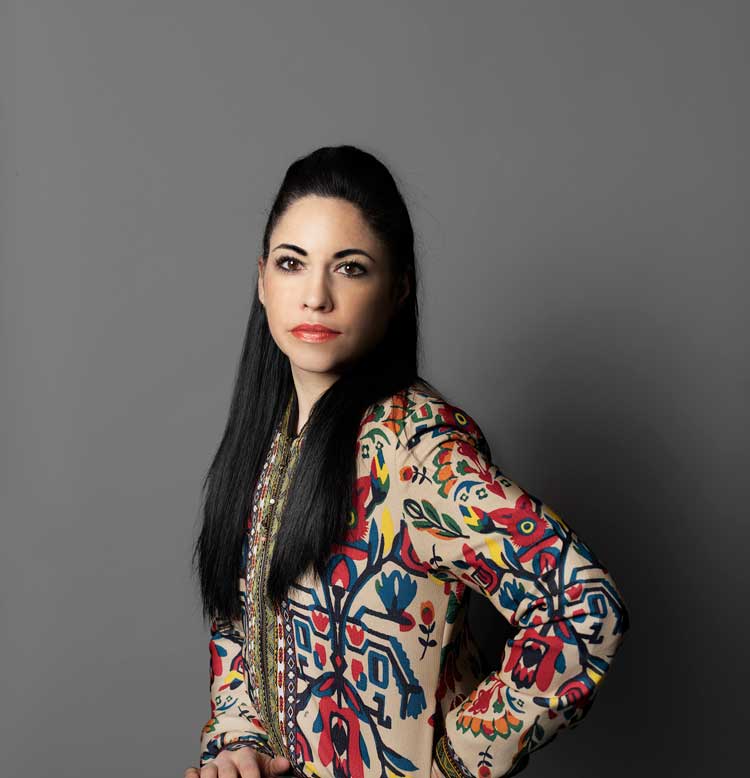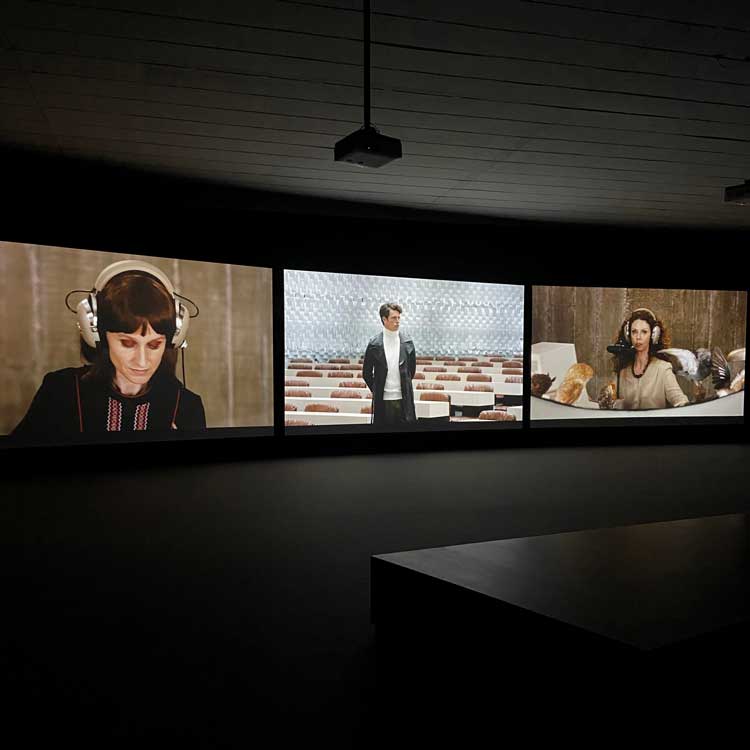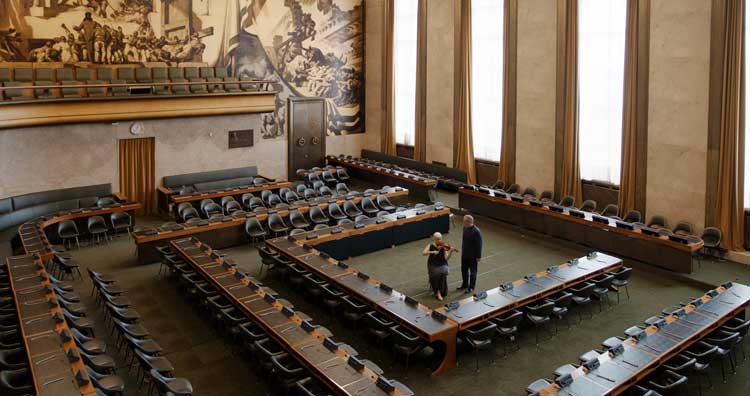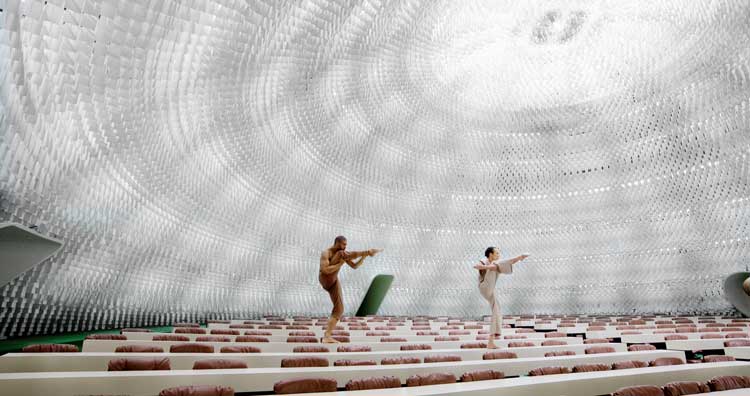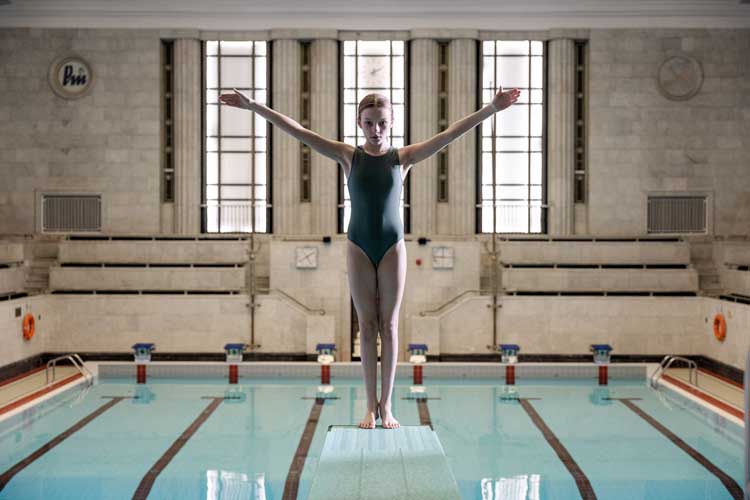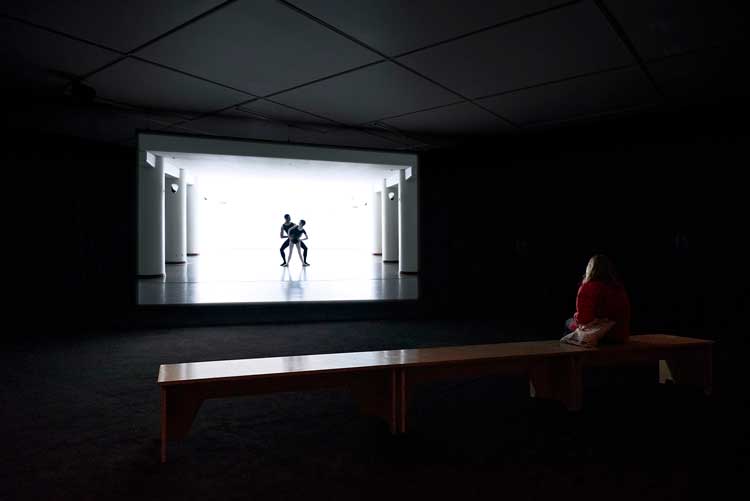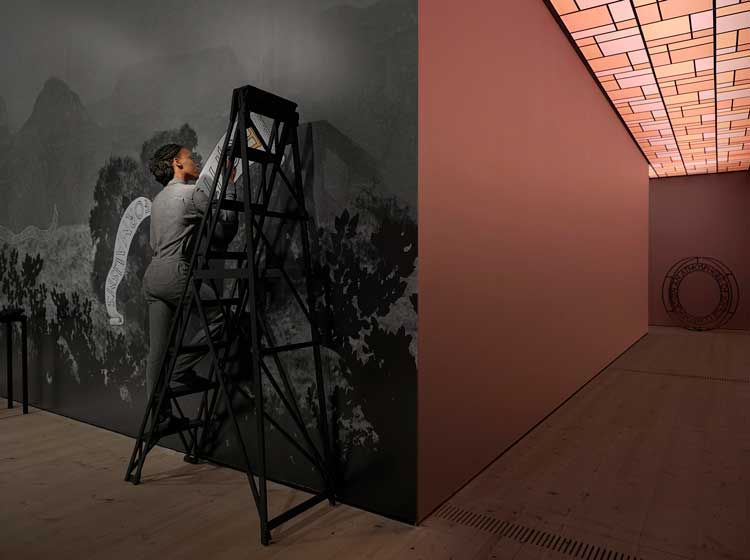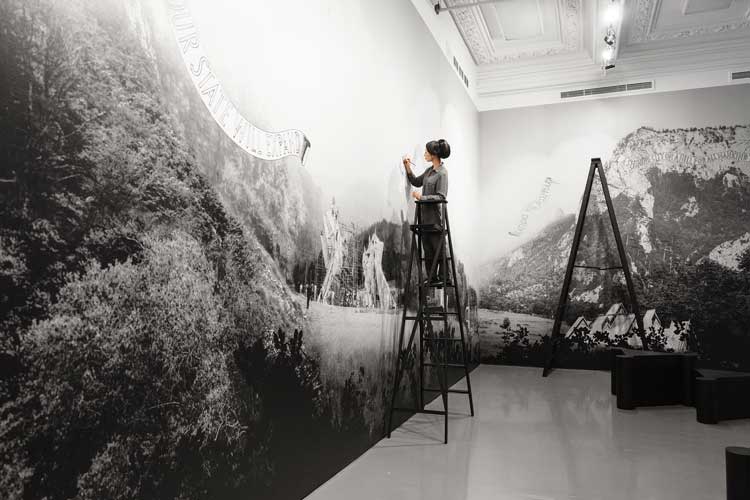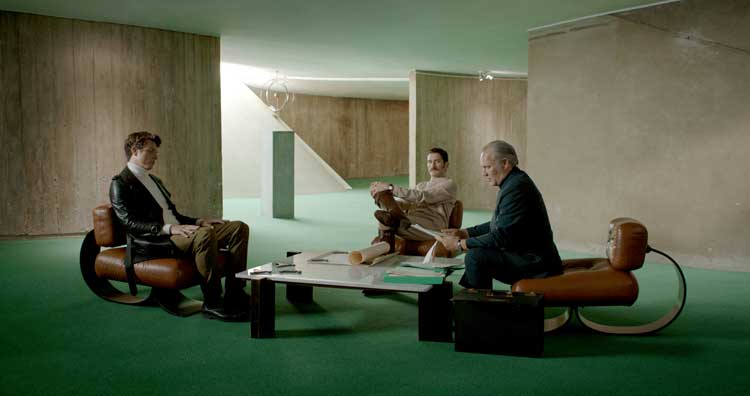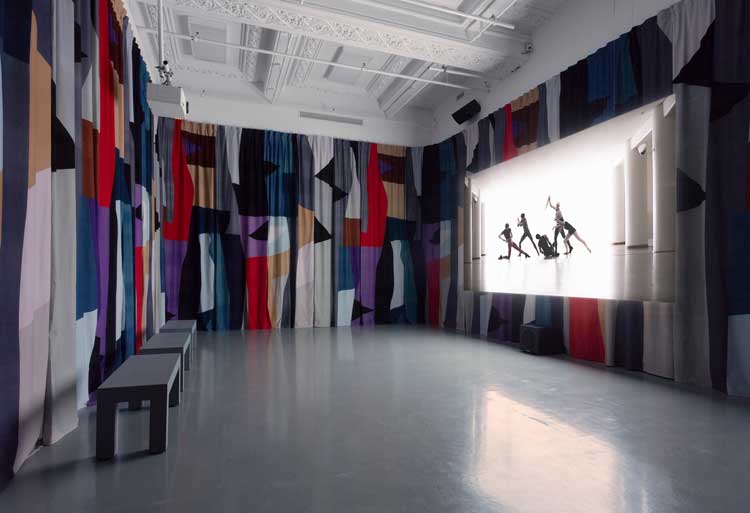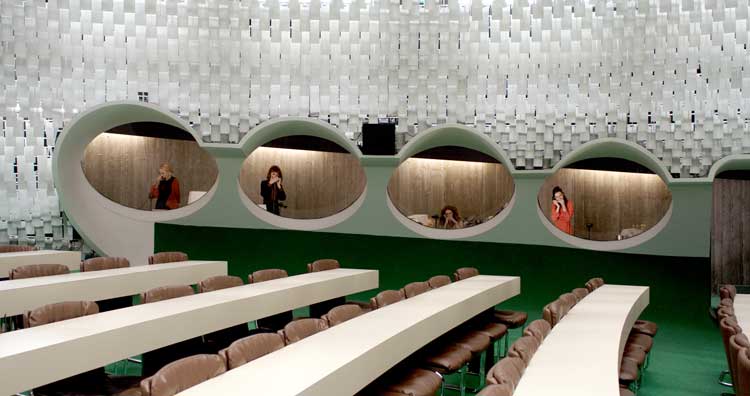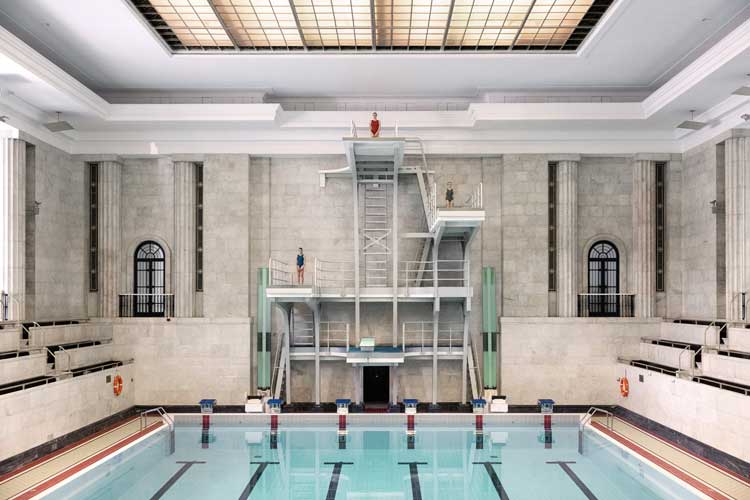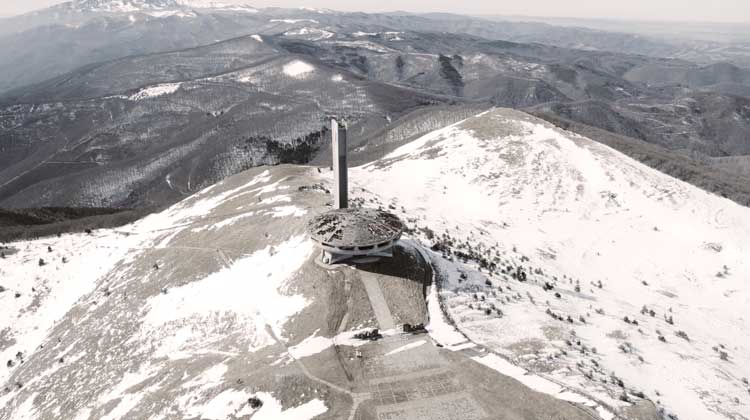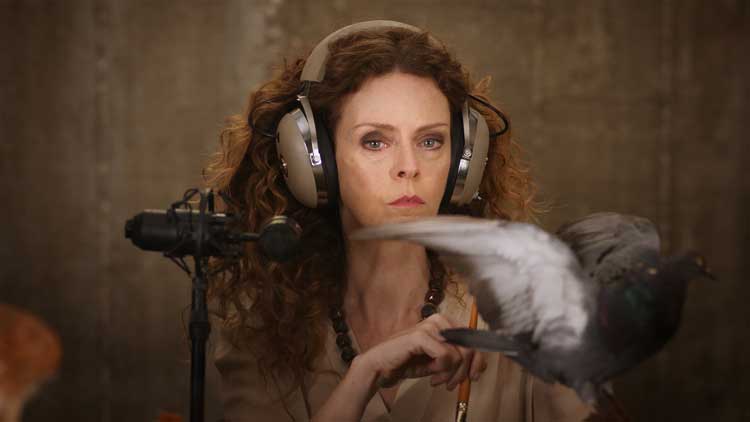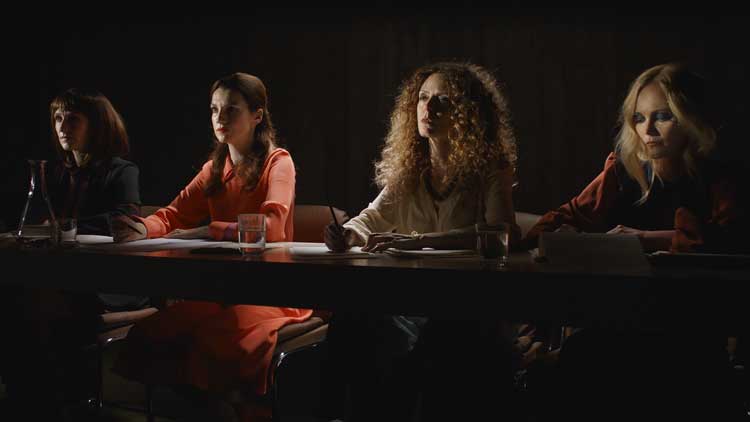

by NICOLA HOMER
The London-based artist and film-maker Jasmina Cibic is attracting international recognition as one of a generation of artists engaging with the legacy of the former Yugoslavia. Cibic unpacks ideas of nation-building and tools of soft power – a form of diplomacy in which culture serves as an instrument for the presentation of national identity – and translates these into films, installations and performances. She weaves the strands of statecraft and stagecraft together in her artistic practice.
[image5]
For Most Favoured Nation, her current exhibition at the Museum der Moderne Salzburg, her first solo show at an Austrian museum, she has created spatial architecture that gives the impression of an expanded form of theatre and explores notions of European identity. With its presentation of the film installation The Gift (2019-21), filmed in monumental architectural landmarks, including the Palace of Nations in Geneva and Oscar Niemeyer’s French Communist party headquarters in Paris, the exhibition explores the role of culture as a political tool, like the artist’s show Stagecraft at the Museum of Contemporary Art in Lyon. The Gift has an allegorical storyline, which takes as its premise a fictitious competition between an artist, a diplomat and an engineer to find gifts that can heal a divided society, and presents characters who represent the four freedoms articulated by Franklin D Roosevelt’s Four Freedoms speech. Similarly, in her new installation, Most Favoured Nation (2022), Cibic draws on words from historic speeches by heads of state, and presents an olfactory work about the idea of Europe, exploring the importance of culture for society.
[image4]
Cibic was born in Ljubljana, Slovenia, in 1979. She had her breakout moment when she represented Slovenia at the 55th Venice Biennale in 2013, where she wallpapered the entire pavilion with images of a rare Slovenian cave beetle and introduced paintings from the historical art collection of the National Assembly of the Republic of Slovenia. Yet she says it would be impossible to do this today, in light of a change in attitudes to culture, artists and free thought, under the current government in Slovenia.
[image6]
In 2018, Cibic held a solo exhibition, This Machine Builds Nations, at the Baltic Centre for Contemporary Art, Gateshead. There, her trilogy of films, Nada (2016-18), had its UK premier. In the films, she looked at three male star modernist architects, commissioned by different nation states to represent the nation at three moments of crisis in Europe: the first world war, the second world war and the cold war. Mies van der Rohe designed the German pavilion for the 1929 Barcelona International Exposition; Arne Jacobsen completed the Aarhus town hall in Nazi-era Denmark; and Vjenceslav Richter created the Yugoslav pavilion for the 1958 Brussels World Fair. Cibic won the 2021 Film London Jarman Award for film works featuring dance performances, including Nada and The Gift. Ahead of her Salzburg exhibition, she spoke by telephone to Studio International. The following is an edited extract from that conversation.
[image8]
Nicola Homer: Congratulations on winning the 2021 Film London Jarman Award. Can you tell me about the jumping-off point for your artistic practice?
Jasmina Cibic: A Russian artist, Ilya Kabakov, said: “Every artist compensates what is lacking.” That’s quite a nice quote to look at any artistic practice. It just sometimes helps us to understand the artistic jumping-off point, as you put it, of why we do what we do, but also there’s always this big distinction between what we think we are doing and what the audience reads it as. Artistic practices coming from spaces that don’t have an established artistic system are often in danger of falling into not-recognisable grounds for the audience, especially because we have been subjected to geopolitical exoticism, in terms of our artistic practices being asked to step into the dominant artistic systematic discourse, when we are used almost as illustrations of these modes of transfer. There is this transfer between art worlds of the dominant western artistic discourse and this periphery, which eastern Europe unfortunately still is.
[image9]
As an artist, I was always drawn towards this relationship of what is the purpose of art, especially because the territory where I’m from has a historical legacy of avant-garde, and the direct interaction between the artist and society ... I began looking into these instances of what it means to come from a territory that is so embedded with these questions of non-existent art systems. How does cultural capital evolve, especially when territories are so subjected to political change and ideological change that national cultural capital changes a lot? It’s undone very quickly when a rightwing government comes in, which is now happening in eastern Europe. All these amazing amassments of creativity that have been so painstakingly created from Poland, Hungary, the former Yugoslavia, artistic practices we have been creating together, and now within this new populist rise of rightwing governments, all of this can quickly be erased. So, these have been my core concerns for almost the past two decades of my practice.
NH: How have you explored ideas of global issues, such as national identity and soft power, and European relations, in your exhibitions running up to the Jarman Award?
JC: It started with the Venice Biennale, and then I didn’t want to stay only within the region, though I did a lot of research surrounding Slovenia and the former Yugoslavia. It was a very interesting melting pot for questions of Europe. If you take any old map, if they’re well-used, when they start to break up, and where the holes develop, is usually around the territory of the former Yugoslavia, which is quite an interesting illustration of what this territory was historically. It was basically the territory where all the trade routes went, where there was lots of hunger for influence of the big powers of colonial Europe. I was looking into this territory, because it was one of the first precursors to this idea of transnationalism in Europe. Yugoslavia was a federation of different republics with different languages, three religions and so on. It came into being because it was a peace project, effectively. The idea of the former Yugoslavia was let’s unite the south Slavs, which were governed by some other authority, and let’s unite in a new state. In terms of that, it’s a really interesting precursor to the idea of a united Europe. I find the Yugoslav war and the nationalism that led the past to it quite an interesting precursor to now, the failings of Europe and the issues we are facing today.
[image11]
It is this idea of the political psychology and unconsciousness of states that I’m quite drawn towards. But apart from the former Yugoslavia and this case study of that, especially the modernist period, so the post-second world war period where arts and culture, and architecture specifically, were really blooming, I was looking at other moments within the European consciousness that went through similar situations, for example Weimar Germany … That’s when we meet Mies van der Rohe, and how he as an architect was selected as this representative of the Weimar Germany to go and reimagine how a true, European, modern citizen will function and live. There is this moment where culture is called on as a game changer of this announcement where this new tabula rasa needs to be reformatted, for the new power elites to be able to make centre stage.
NH: I’d like to ask you about your piece The Gift, recognised by the Jarman Award, which features in your exhibition in Salzburg. Could you tell me about it?
JC: Up to this last film, I had been looking more at instances of commission. I was very interested in what happens when artists and architects, and other cultural workers, are commissioned by an authority to create a work. But then with this new body of work, I started looking at the concept of gifting, of political gifts, of culture effectively, where we have different relations … If you return a gift, it ceases to be a gift. I was reading Marcel Mauss and a story that comes from anthropology. I quite liked this idea of culture being a gift, so I really wanted to play with it as a thesis. The Gift was a film, which was entirely built from political gifts of culture, from location, from script to costumes, characters, everything was taken out of research surrounding case studies of gifts of culture in political terms.
[image3]
We filmed inside the Palace of Nations in Geneva, which was a gift in itself. The interior is full of gifts from member states. Then we filmed in the Oscar Niemeyer French Communist party headquarters in Paris, which was a gift from the architect to the communist party of France; Mount Buzludzha in Bulgaria, another Communist party headquarters, which was a gift from the citizens of Bulgaria to the new socialist sort of faith; and the Palace of Culture and Science in Warsaw, which was a paradoxical gift from Stalin to the new Soviet state of Poland. These were our locations, our theatres. All of them have lost these central figures, who were the giftees. Then I populated them with a simple narrative, which tells the story of a fictitious competition to find the gift that can heal a divided nation. The premise of the film is that this gift is culture because it is the only idiom that does not have wear and tear, so it can be reused in perpetuity.
[image2]
NH: Could you also tell me about your recent exhibition, Stagecraft, at the Museum of Contemporary Art in Lyon, in which The Gift features, too?
JC: This was my last solo show. It opened last September and ended this January. It was a large-scale exhibition that presented The Gift as a three-channel film installation together with a new installation, which presented a reactivation of a scenography for a ballet, The Miraculous Mandarin, which premiered in 1927 at Cologne Opera House and was censored by Konrad Adenauer, the Mayor of Cologne at that point. This is a pantomime ballet by Béla Bartók and it was marred by state censorship until 1958, when Yugoslavia chose it as its central artwork to bring to Brussels for the first world exposition after the second world war … It was almost like a debutante dance of the new power structures after the trauma of the second world war. Countries were extremely conservative. Modernism was the main flavour. What was phenomenal with Yugoslavia was that it brought out these extremely modernist groundbreaking pieces, because it needed to show its break with the west, so mostly with America, but also with Soviet Russia, because Stalin and Tito had an ideological break a few years before. So, Yugoslavia was in this tabula rasa moment where it had to rewrite its aesthetic space.
[image14]
NH: May I ask you to talk about your first solo show in an Austrian museum [which opened earlier this month]? I understand that it places you as a representative of a generation of artists who engage critically with the legacy of the former Yugoslavia. How do you engage with this legacy and perhaps questions of the responsibility of the international community?
JC: The show in Salzburg, the title of which is The Most Favoured Nation, is effectively looking through the prism of the most-favoured nation, a clause in the trade contracts that the World Trade Organisation (WTO) came up with after the second world war, which were contracts to make trade between nations easier and more just. Paradoxically, a clause with this name has been taken from the WTO agreement and used in entertainment contracts. It’s a clause mostly used within the entertainment industry to delegate the rights of different actors, or different artists who have the same role, or the same size of role, that need to be treated the same.
This is an exhibition that we have been working on during the pandemic, so it’s more than a legacy of the former Yugoslavia. It’s looking at ourselves now in this situation of Europe, and how different European artistic practices are dealt with or navigated, based on these support systems that individual countries have put in place, and also how this international arts arena operates with them all. So, is there this most favoured nation’s clause? And we know it, there isn’t. We used to have this joke that every proper private gallery has to have an Austrian artist because you get really good support from Austria, and Austria’s soft-power extensions. It’s really to look at, again, at the crisis, and this potential disappearance of artistic practices that are coming from the periphery of Europe. Here again, it is not only the former Yugoslavia, it’s also many other countries that are coming on to this agenda. The entire exhibition in Salzburg is looking at a historical sweep of this misuse and abuse of culture in the hands of national powers.
NH: Are you able to tell me about one or two works that might capture these ideas?
JC: The idea was we would make a new film for this exhibition. As we were entering the pandemic, it became impossible. So, during the pandemic, I began collecting roses, named after the founding fathers of the idea of a united Europe. This was during the first wave of the pandemic. All the European borders were shut or shutting, and I was sourcing these roses, most of which were bred at the start of the 20th century and named after statesmen including Konrad Adenauer and Sandro Pertini. Also, we have Winston Churchill, we have Charles de Gaulle. Of course, these are roses that are hardly accessible anymore. Loads of them have almost disappeared … This was a symbolic exchange of actually trying to find these founding fathers of this idea of a united Europe and effectively smuggling them across these closed borders to a botanical garden in Salzburg. So, we planted them there and then, when they bloomed, we combined their scents. Now in Salzburg, one of the main works within the exhibition is this scent. Effectively, it is a cross-pollination, metaphorically, of these founding fathers of European thought. My obsession with roses is not just because of this naming, but also because rose cultivation began with political power. It was Napoleon’s first wife, Josephine, and her gardener, who first began to cross-pollinate roses to create new types. Then of course, roses were tied to political power. The rose is a symbol of the suffragettes: what we need for life, if we quote the suffragettes, is bread and roses. Of course, we need bread, but we also need culture. Here, this is the main question. You can give people whatever bread, because they just need to survive. But what kind of a rose, what type of a culture they chose, needs to be up to them.
NH: Absolutely. That’s a very good point that you make. Do you consider yourself an internationalist?
JC: Well, I lost the country where I was born. So, I no longer have a country I would identify with. I left home when I was 17 and did my studies in Italy and then in the UK. I mostly work with different countries. I definitely do not ascribe to myself any territorial belonging. During the pandemic, the one really nice thing was that, as much as we hate Zoom, there has been this new discovery or rediscovery of many creatives with shared belief systems that are dispersed all around the world, especially teaching in academia, with which we have managed to create an international circle of likeminded thinkers and investigators of contemporary thought, and most of them teach as well. It has been wonderful to be able to connect with students from all over the world to really ignite this cross-pollination of transnationalism, which I think is very much needed today.
NH: It’s very important. It’s good to see a silver lining to the grey cloud of the pandemic. Thank you for that positive note to end on.
• Jasmina Cibic: Most Favoured Nation is at the Museum der Moderne Salzburg until 12 June 2022
